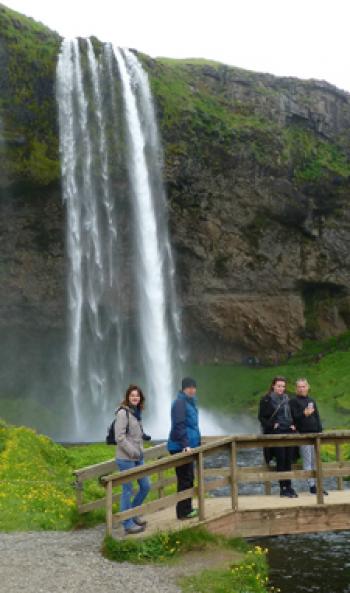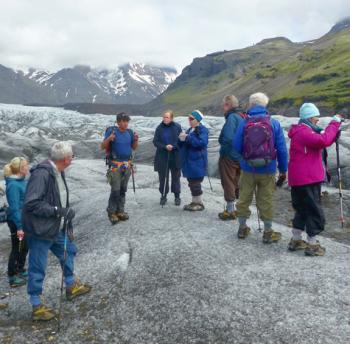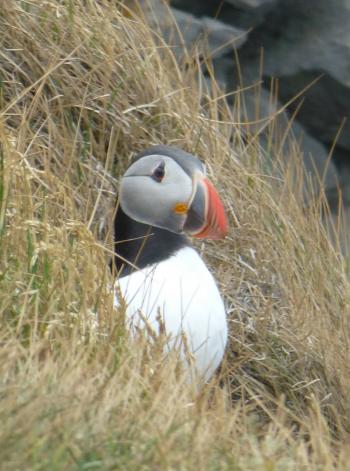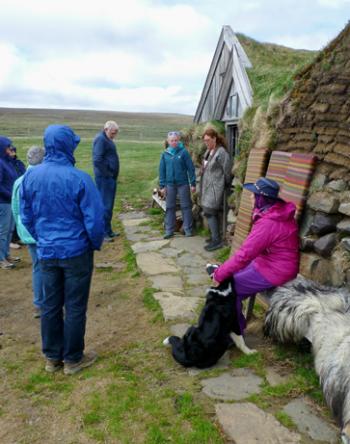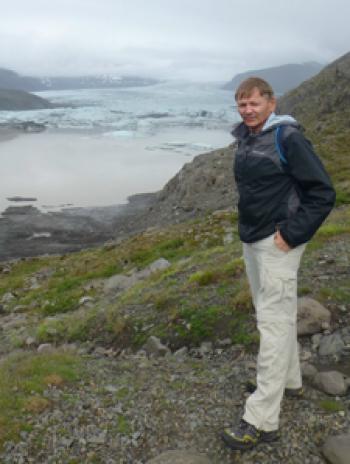Far Horizons : Iceland
This item appears on page 57 of the November 2016 issue.
Iceland (Second of three parts)
My exciting Icelandic adventure continued from the whale-watching mecca of Húsavík, in the north, with a day exploring some of the many attractions of the highly popular Lake Mývatn region. I was traveling (partially hosted) with a group of 11 explorers on a tour with Toronto-based ElderTreks in June 2016.
Mývatn is regarded as a birding paradise, even playing host to the largest breeding duck colony in Europe. On this day, we saw few ducks and concentrated our efforts on the many craters, lava fields, steam vents, gurgling mud pools and geothermal soaking pools that accented the lunar-like landscape.
I particularly enjoyed a hike from the parking lot to the rim of the 2,500-year-old Hverfjall Crater, which is a perfectly formed tephra cone (one formed of consolidated ash and pumice). While our time did not permit, I recommend allowing about two hours for the gravel-track walk around the caldera rim, which rewards hikers with expansive views, including perspectives of Lake Mývatn and its scattering of islands.
An interesting lava forest walk, the steamy bubbling-mud and sulfur pools of Hverarönd and an educational visit to the Krafla geothermal power station were among our diverse experiences in the region.
At the power plant, we learned about the history of eruptions of the mighty Krafla Volcano, including violent eruptions only two kilometers away during the station’s construction in the 1970s. Exhibits in the visitors’ center help explain the plant’s inventive application of geothermal engineering.
Later, we passed through ancient mountains, seeing rocks carved during the last ice age. We spent the night in Egilsstaðir, the largest town in the eastern part of Iceland.
While in Iceland’s northern highlands, we stopped to visit Sænautasel, a reconstructed old, Nordic farm that makes clear the hardships of remote, rural living in times past. There, as just about everywhere we visited on the island, local woolen goods were for sale at prices that seemed to discourage rather than tempt most visitors.
This was also another day of visiting magnificent waterfalls, which by this time were beginning to feel almost commonplace.
Glacier country beckons
Turning southward, our group entered glacier country, our overnight destination being the idyllic coastal village of Höfn, located on a peaceful estuary in the southeast and sporting views of the massive, although shrinking, Vatnajökull ice cap, one of the largest ice sheets on the planet.
Vatnajökull, the amazing Jökulsárlón Glacier Lagoon and Skaftafell National Park captivated our small band of adventurers for the next two days. This was the dramatic Iceland we had all traveled to see.
Highlights included inspecting icebergs up close and personal on a cruise in Jökulsárlón Glacier Lagoon aboard an amphibious vehicle — a photo op extraordinaire. Our onboard guide provided a crash course in iceberg formation, characteristics and behavior.
On foot, we visited the magnificent Svartifoss, a photogenic waterfall located in a columnar basalt gully.
Finally came an opportunity to conquer the ice, as, with crampons strapped onto our boots, we clawed our way across a small section of the glacier on a one-hour guided hike, which resulted in photos that were perhaps a bit more intriguing than the experience, itself.
It was most helpful to have a 2-night stop at Skaftafell to prepare for the final leg of our now-westbound journey along the south coast toward Reykjavik, which I will report on in next month’s column.
Iceland confidential
Divert I must, now, from the attractions of the island to its residents and their lifestyle.
Before departing from home, I knew I would likely be captivated by the raw, natural-world attractions of Iceland, but, in truth, I held no such expectation regarding the islanders, themselves. I found, however, a people of a strong, resolute collective consciousness, proud of their small country and its many accomplishments both at home and on the world stage.
Our small group immediately became loyal fans of the national football (soccer) team as, during our journey, they made their way through to the final rounds of the Euro Cup (UEFA European Championship), the world’s top stage for the sport.
This upstart team from an island with only 332,000 residents had no business playing to a tie with eventual champion Portugal (pop. 10.6 million), then easily dispatching a powerhouse like England (53 million) before finally succumbing to France (64.7 million) in the final eight.
With our excellent guide, Gugga Eiriksdóttir, and a gaggle of Icelanders, we passionately cheered as adopted natives during the two games we watched in our hotel pubs. The whole country was being carried by this sporting groundswell, and we were grateful to be along for the ride.
In the realm of personal safety, crime rates in Iceland are low, especially violent crime. Small children play without adult supervision, including walking to school on their own when the weather permits.
The cost of living on the island is not cheap, which may be a good thing, overall. Icelanders relish and are appreciative of the advantages of being a small, rather remote island nation without land borders to defend. In addition, the country’s immigration policy is highly protective in terms of preserving the island’s culture.
To be sure, no place, including alluring Iceland, is immune from economic and other modern-world challenges. This special place on the planet, however, does seem to have a strong-enough sense of self to sensibly and vigorously protect its many virtues.
Iceland tour details
ElderTreks’ annual 11-day Iceland adventure will next operate June 15-25, 2017. The land-only cost is $6,495 per person, double occupancy, including all meals and sightseeing. The single supplement is $1,295.
The tour is limited to a maximum of 16 passengers. (My 2016 tour operated with only 11.) Importantly, the tour departure is guaranteed.
Contact ElderTreks (597 Markham St., Toronto, ON, M6G 2L7, Canada; 800/741-7956, eldertreks.com).
You may reach Randy at 80 America Way, Jamestown, RI 02835; 401/560-0350, randykeck@yahoo.com.

